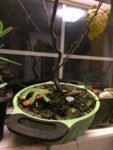Leo in N E Illinois
The Professor
- Messages
- 11,488
- Reaction score
- 23,836
- USDA Zone
- 5b
Nice to see Ostrya being used for bonsai. I have half a dozen seedlings in 3rd and 4th summer of growth. I agree that Ostrya, Ironwood, is not as tough or resilient as elm, it is a bit delicate, but Ostrya has proven much more resilient than Carpinus. In the wild, Carpinus are in the secondary flood plains, down to the stream or riverbanks. Carpinus is definitely an understory tree. Ostrya is similar except it tends to be found in drier habitats. More upland from the streams. Usually Ostrya is found where it rarely or never floods with standing water. Ostrya can also be found in more open forest edge habitats. It takes to full sun much better than Carpinus. Neither want to be as dry as a red or black oak, neither is drought tolerant, but Ostrya will come back from getting too dry in the pot more easily than Carpinus. For me Carpinus will die the first time they are allowed to dry to wilt point. Ostrya usually come back from the wilt point. This is just my personal observations, they are different enough in growth habit that it makes sense that they are in different genera. So compared to Carpinus, Ostrya likes a little more sun, a little less water. Compared to an elm, Ostrya want less sun, more water. Ostrya are slightly more tolerant of media that is not mildly acidic, or they do not require as strongly an acidic media, where Carpinus really does want a media that is nearly as acidic as what we provide azaleas.
I would not use an all inorganic media for Ostrya, nor Carpinus. Both like a media more like what a Japanese maple would like, fairly high in organics, mildly acidic and holding a good amount of moisture while still being able to breathe. 100% DE is a poor choice. I use a blend that is about 1/3rd composted fir bark. The rest is pumice, and akadama or pumice, lava, DE, and composted bark. Again the bark is a large component.
Nothing wrong with DE, or Turface, or Hydroton, Haydite or the miriad other inorganic media, none of them should be used as sole component in a mix. !00% anything is probably a poor choice. Exception is pumice, 100% pumice is excellent for establishing newly collected trees. Once a tree is established, a blend should replace 100% pumice.
I would not use an all inorganic media for Ostrya, nor Carpinus. Both like a media more like what a Japanese maple would like, fairly high in organics, mildly acidic and holding a good amount of moisture while still being able to breathe. 100% DE is a poor choice. I use a blend that is about 1/3rd composted fir bark. The rest is pumice, and akadama or pumice, lava, DE, and composted bark. Again the bark is a large component.
Nothing wrong with DE, or Turface, or Hydroton, Haydite or the miriad other inorganic media, none of them should be used as sole component in a mix. !00% anything is probably a poor choice. Exception is pumice, 100% pumice is excellent for establishing newly collected trees. Once a tree is established, a blend should replace 100% pumice.





